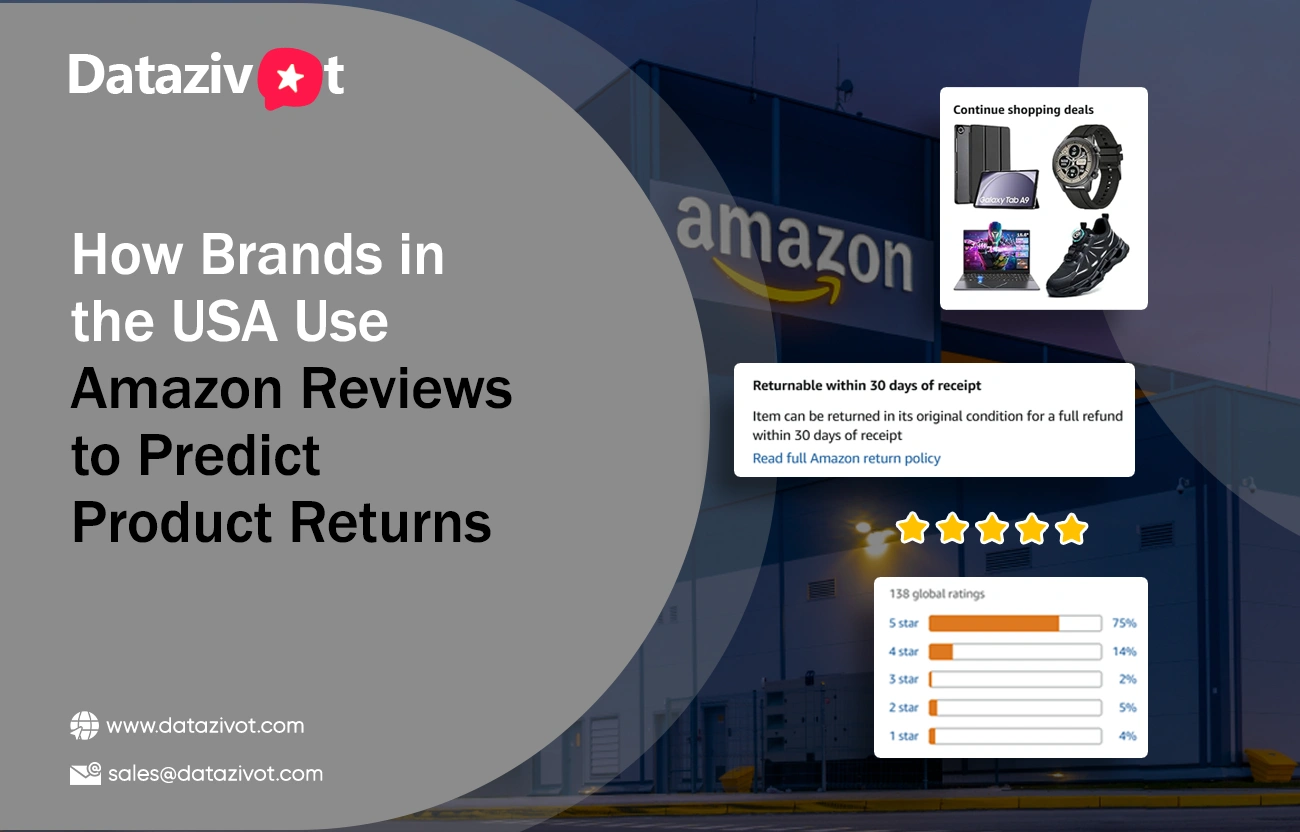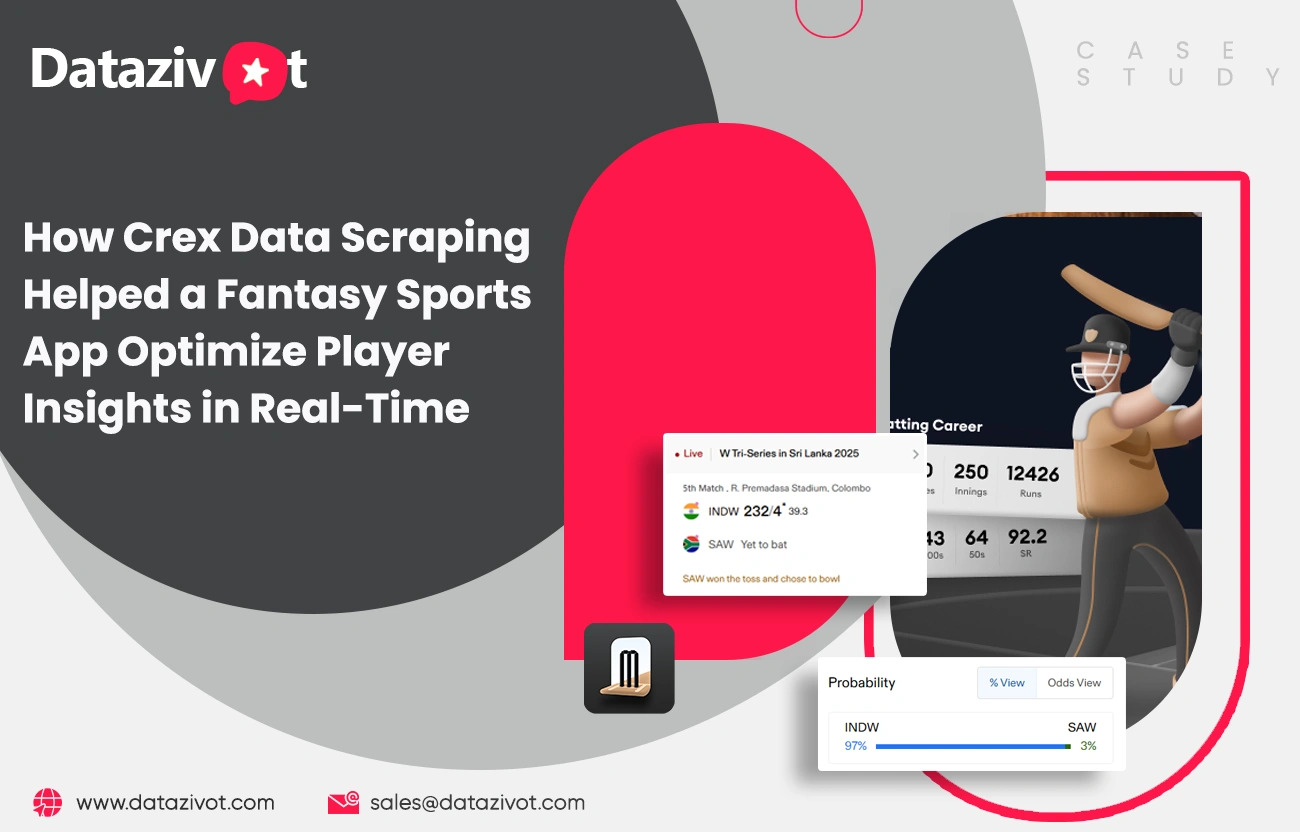Predicting Product Returns from Amazon Reviews – USA Brands' Approach

How Brands in the USA Use Amazon Reviews to Predict Product Returns
Introduction
The Unseen Link Between Reviews and Returns :
For U.S.-based brands selling on Amazon, product returns can eat into margins, hurt seller ratings, and damage customer trust. What if you could forecast return rates before they occur? Enter review scraping and sentiment analysis—where Customer Reviews Data becomes a goldmine for predictive analytics. At Datazivot, we specialize in mining Amazon reviews to extract actionable insights that help brands reduce return rates and boost customer satisfaction.
Why Predicting Returns Matters in the U.S. Market
Returns in the U.S. eCommerce space, especially on Amazon, can be alarmingly high. According to the National Retail Federation, return rates for online purchases in the U.S. averaged 18% in 2024, with categories like apparel, electronics, and beauty among the highest.
The Costs of Returns:
Logistics: Reverse shipping and restocking fees
Reputation: Negative impact on seller ratings and visibility
Inventory Loss: Unsellable or used returns
Customer Churn: Poor experience leads to lost loyalty
That’s where review intelligence steps in—allowing brands to proactively detect dissatisfaction signals.
What is Amazon Review Scraping?
Amazon Review scraping refers to the automated extraction of review data from Amazon product pages. Datazivot’s systems collect:
Star ratings
Review titles & bodies
Review dates
Verified vs non-verified tags
Review helpfulness votes
Product metadata (ASIN, brand, category)
With thousands of reviews per SKU, machine learning models are trained to:
Spot negative trends early
Analyze complaints by feature (e.g., size, color, battery life)
Predict Product Returns
Sample Data Extracted by Datazivot
How U.S. Brands Use Review Data for Return Prediction
1. Identifying Patterns of Complaints
Natural Language Processing (NLP) models, trained on millions of reviews, help identify root causes of dissatisfaction. For example:
“Too small,” “tight,” “not as pictured” — common phrases in fashion returns
“Stopped charging,” “won’t boot,” “heats up” — frequent in electronics
2. Review-Based Return Score
Each review is tagged with a Return Intent Score (RIS) ranging from 0 to 1, predicting return likelihood. Brands track:
Category-wise return prediction rates
SKU-level anomalies
Impact of product versions (v1 vs v2)
3. Time-Based Return Trend Detection
Datazivot maps reviews over time to spot:
Spikes in negative sentiment after a product update
Seasonal complaint trends (e.g., winter jackets, summer gadgets)
Effect of promotions or influencer campaigns
Example Insight:
A U.S. shoe brand noticed a 40% rise in predicted returns post Black Friday 2024—mainly due to “wrong sizing” comments. They optimized size charts in December, resulting in a 25% drop in January returns.
Use Case
Predicting Returns for Electronics Category :
Brand: TechGuard USA
Platform: Amazon.com
Category: Home Security Cameras
Monthly Reviews Scraped: 12,000
Return Prediction Accuracy: 87%
Findings:
26% of 1-star reviews mentioned "device not connecting"
Return rate for flagged SKUs was 3.4x higher than others
A firmware update resolved most connectivity issues
Action Taken:
TechGuard included a troubleshooting guide and clearer Wi-Fi setup instructions. Result? 18% fewer returns in Q1 2025.
Top Keywords Associated with High Return Intent (2025)
These trigger terms help Datazivot build return risk models by product category.
How Datazivot Supports Amazon Sellers in the USA
Case Study: Apparel Brand Reduces Returns by 22%
Client: UrbanFit USA
SKU Focus: Athleisure & gym wear
Challenge: High return rate (31%) for leggings and sports bras
Solution:
Scraped 80,000+ reviews
Found “transparency,” “fit too tight,” and “color not same” as major issues
Introduced detailed size charts, fabric info, and image contrast correction
Results:
22% drop in returns
16% improvement in positive reviews
RIS alerts helped catch sizing issue in a new product within 10 days of launch
Benefits for USA-Based Brands Using Datazivot
1. Lower Return Costs: Predict and resolve issues before customers return products
2. Enhanced Listings: Improve product copy, FAQs, and visuals based on feedback
3. Smarter R&D: Feed real complaints into product development
4. Operational Efficiency: Reduce customer support load
5. Boosted Ratings: Fewer bad reviews, better rankings, higher conversions
Future Outlook
Merging Reviews with Return Data :
Many top-tier U.S. brands are now pairing Amazon review data with actual return logs to create predictive pipelines:
If Review X = [low rating + “poor fit”] → 78% chance of return
If Review Y = [high rating + “quick delivery”] → 5% chance of return
These predictive pipelines are part of automated return mitigation strategies adopted in 2025.
Conclusion
Your Reviews Know More Than You Think :
For every product sold, hundreds of insights lie buried in the reviews section. By partnering with Datazivot, brands in the USA are transforming these comments into cost-saving intelligence.
If you’re an Amazon seller or D2C brand looking to control returns, increase profit margins, and build stronger customer satisfaction—Amazon review scraping is no longer optional. It’s essential.
Originally Published By https://www.datazivot.com/usa-brands-use-amazon-reviews-to-predict-returns.php
Note: IndiBlogHub features both user-submitted and editorial content. We do not verify third-party contributions. Read our Disclaimer and Privacy Policyfor details.







